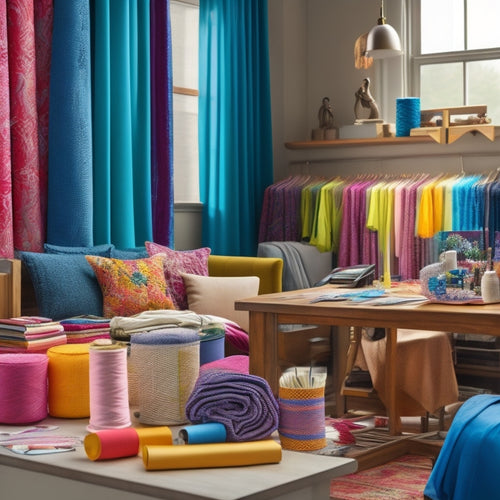
Arts' Decline Threatens Cultural Richness: Urgent Reversal Needed
Share
You're witnessing the arts' decline, and it's endangering our cultural richness. As a society, we're undervaluing the creative expression that fosters diversity, emotional intelligence, and human connection. Financial constraints and STEM-centric education are suffocating arts programs, limiting access and opportunities. This neglect has devastating consequences, as arts take a backseat to technical pursuits. You have a pivotal role to play in preserving our cultural heritage and reviving the arts movement. By engaging with local artists, advocating for increased funding, and exploring unconventional career paths, you can help spark a reversal. The fate of our cultural richness hangs in the balance – will you take the next step?
Key Takeaways
• The decline of arts education in schools has led to a lack of exposure to diverse creative expression, threatening cultural richness.
• Prioritizing STEM fields over arts has resulted in a decline in creative thinking, problem-solving, and emotional intelligence.
• Budget cuts and lack of funding for arts programs have limited access to arts education, particularly for underprivileged communities.
• The undervaluation of arts has led to a decline in cultural institutions, threatening the preservation of cultural heritage.
• Reviving interest in arts and increasing funding for arts programs is crucial to enrich society and preserve cultural richness.
The Value of Arts Education
As you explore the significance of arts education, you'll uncover that it fosters a distinctive way of learning that not only complements traditional academic disciplines but also cultivates creativity, emotional intelligence, and human connection.
By embracing arts education, you'll discover a diverse range of benefits that extend beyond the classroom. It promotes diversity by exposing students to various forms of creative expression, allowing them to develop a deeper understanding of different cultures and perspectives.
In addition, arts education enhances emotional intelligence, enabling individuals to navigate complex social situations with empathy and sensitivity. By prioritizing arts education, you'll be investing in the development of well-rounded, creative, and emotionally intelligent individuals who can thrive in an increasingly interconnected world.
Financial Constraints on Creativity
When you're forced to choose between STEM and arts education, the financial constraints of pursuing a creative passion often tip the scales, leading you to sacrifice your artistic aspirations on the altar of fiscal responsibility. This dilemma is all too familiar, as schools prioritize STEM programs over arts education due to perceived financial gains.
| Financial Constraints |
Budget cuts in arts programs limit access to arts education, stifling creativity.
Financial struggles for artists discourage individuals from pursuing artistic careers.
Prioritizing STEM over arts neglects the value of arts in fostering creativity and emotional intelligence.
Lack of funding for artistic endeavors hinders innovation and diversity in the arts.
As a result, you're left to navigate the challenges of pursuing a creative passion in a society that undervalues the arts. This can lead to a decline in cultural richness, as the next generation of artists and creatives are discouraged from exploring their talents.
Beyond Traditional Career Paths
Your passion for the arts can lead you down unconventional career paths, where creative expression and innovation converge with entrepreneurship, social impact, and community engagement.
As you explore alternatives to traditional artistic pursuits, you'll discover a world of possibilities that blend artistic vision with practical application.
Consider the following unconventional opportunities:
- Arts administration: managing galleries, festivals, or cultural institutions
- Social entrepreneurship: using art to drive social change and community development
- Design thinking: applying creative problem-solving to real-world challenges
- Cultural consulting: helping businesses leverage the power of art and culture
- Community arts programming: developing initiatives that promote social cohesion and artistic expression
The Arts in Decline
You've likely noticed that the arts have taken a backseat to STEM fields in recent years, with public schools and governments increasingly prioritizing technical education over creative pursuits. This shift has led to a decline in the arts, threatening the cultural richness of our society. As a result, arts programs are often the first to face budget cuts, and students are left without exposure to diverse forms of expression.
| Consequences of Arts Decline | Impact on Society |
|---|---|
| Limited creative outlets | Decreased cultural significance |
| Reduced emotional expression | Less diverse perspectives |
| Neglect of human connection | Impoverished cultural heritage |
Reviving interest in the arts is essential to preserving cultural richness. By recognizing the importance of arts education, we can foster creativity, emotional intelligence, and human connection, ultimately enriching our society.
Preserving Cultural Heritage
As the arts continue to decline, it's essential that we take proactive steps to preserve our cultural heritage, recognizing the importance of creative expression in shaping our collective identity.
You have a vital role to play in preserving traditions and fostering cultural appreciation. Here are some ways you can make a difference:
-
Support local artists and artisans by attending their performances and exhibitions
-
Learn about and engage with different cultural practices and traditions
-
Encourage children to explore their creative side through arts education
-
Advocate for increased funding for arts programs and cultural institutions
-
Celebrate cultural diversity by attending cultural festivals and events
Fostering Creative Expression
By embracing diverse forms of creative expression, individuals can tap into their unique perspectives and experiences, fostering a rich tapestry of artistic voices that reflect the complexity of human emotion and thought.
As you explore various art forms, you'll discover new avenues for self-expression, allowing you to process emotions, challenge your thoughts, and cultivate emotional intelligence.
This journey of creative discovery can lead to profound personal growth, as you develop a deeper understanding of yourself and the world around you.
By nurturing your creative spirit, you'll become more empathetic, open-minded, and better equipped to navigate life's complexities.
Reviving the Arts Movement
In today's era of STEM-dominated education, it's imperative that you spearhead a counter-movement, one that revives the arts as an essential component of a well-rounded education, fostering creative expression, emotional intelligence, and human connection.
To achieve this, you can:
-
Embrace innovative approaches to arts education, such as interdisciplinary collaborations and project-based learning
-
Foster community engagement through public art installations, performances, and exhibitions
-
Develop arts programs that cater to diverse learning styles and abilities
-
Provide opportunities for students to explore various art forms, from visual arts to music and theater
-
Encourage cross-pollination between arts and STEM fields to promote creative problem-solving and critical thinking.
Frequently Asked Questions
Can Arts Education Improve Students' Emotional Intelligence and Empathy?
You'll find that arts education can greatly enhance your students' emotional intelligence and empathy by fostering social skills through collaborative creative expression, helping them develop a deeper understanding of themselves and others.
How Do Budget Cuts Affect the Quality of Arts Programs in Schools?
As you navigate the corridors of your alma mater, you're acutely aware that dwindling funds stifle creative expression, compromising the quality of arts programs, and, subsequently, the very essence of students' emotional intelligence and empathy, stifling their capacity for self-expression.
Are There Any Successful Artists Who Did Not Attend Art School?
You'll be surprised to know that many successful artists are self-taught, achieving independent success without formal art school training, relying on innate talent, dedication, and perseverance to hone their craft.
Can Technology Enhance or Replace Traditional Art Forms?
You might be surprised to learn that 70% of artists now use digital tools in their creative process. As you explore the intersection of tech and art, consider how digital art and virtual reality art can augment, rather than replace, traditional forms, offering new dimensions of expression and engagement.
What Role Do Parents Play in Encouraging Children to Pursue Arts Education?
As a parent, you play a crucial role in fostering your child's artistic exploration by encouraging creativity, attending performances, and providing resources, ultimately nurturing their passion for arts education and lifelong appreciation.
Related Posts
-

Why Makeup Artists Need Innovative Design Tools
You're pushing the boundaries of makeup artistry, and traditional tools are holding you back. Innovative design tools...
-

Design Costumes Like a Pro in 5 Essential Steps
To design costumes like a pro, start by upcycling materials and exploring thrift stores for hidden gems. Next, welcom...
-

Explore Vibrant World of Online Dance Learning
The world of online dance learning offers an unparalleled domain of possibilities, where dancers of all levels can ac...


